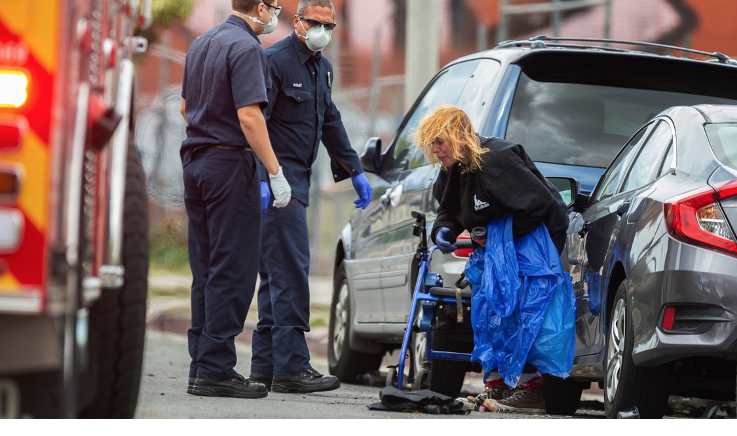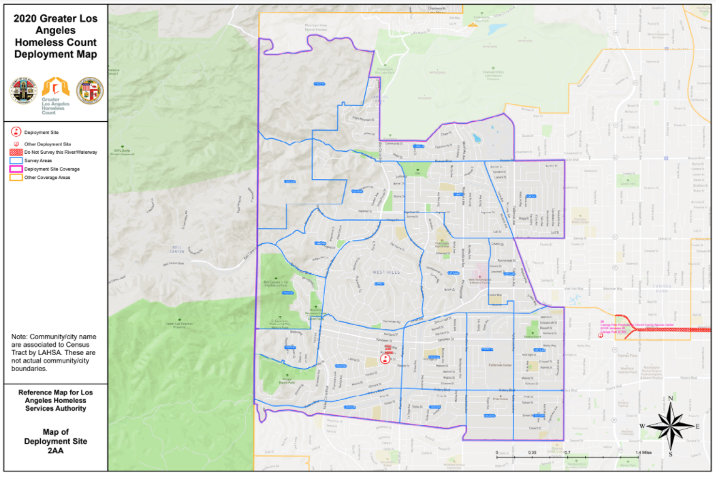CommentsHOMELESS POLITICS - The 2022 Homeless count is especially important to me because the Homeless Crisis affects everyone in our County.
In January 2022, I volunteered my husband and me as a pair from the same household to do the Homeless Count as the result of an appeal by a West Hills Neighborhood Council Board member for pairs from the same household to everyone on a West Hills Neighborhood Council Board meeting held by ZOOM. At that time, the 2020 Homeless Count was scheduled for the San Fernando Valley on January 25th, 2022.
That count was postponed because of the COVID – 19 pandemic and the surge of cases in Los Angeles County. As a volunteer, I received this email from LAHSA (Los Angeles Homeless Services Authority).
“To our dedicated volunteers,
I wanted you to be among the first to know that the Los Angeles Homeless Services Authority (LAHSA) is postponing the 2022 Greater Los Angeles Homeless Count to February 22-24, 2022.
While we work to ensure an accurate Homeless Count, we cannot ignore the surging number of positive COVID-19 cases across our region. Even with safety precautions such as moving training online, developing outdoor deployment sites, and keeping households together, moving forward with a count in January places you, our unhoused neighbors, our staff, and the accuracy of the Homeless Count at risk.
Even before the Omicron variant led to a surge, we made several anticipated design changes to the 2022 Homeless Count to limit COVID-19 transmission, including:
- Moving most deployment sites outdoors— at many sites, volunteers will not leave their cars to pick up their count packets
- Moving training sessions online to minimize the time volunteers spend at the deployment sites; COVID safety instructions are included in the training
- Encouraging all volunteers to sign up as a “safety bubble” of two to three people and arrive at the deployment sites together to minimize cross-group interactions
- Requiring all volunteers to use masks
- Encouraging all volunteers to be vaccinated
Even with these precautions, we understood that the ongoing pandemic might make you feel uncomfortable going out to count our unhoused neighbors. To ensure the most accurate count possible, we requested permission from the U.S. Department of Housing and Urban Development’s (HUD) to hold the Homeless Count in late February. HUD recently granted our request.
The Homeless Count will proceed in February as follows:
- Tuesday, February 22, 2022: San Gabriel and San Fernando Valleys
- Wednesday, February 23, 2022: West Los Angeles, Southeast Los Angeles, & the South Bay
- Thursday, February 24, 2022: Antelope Valley (morning), Metro Los Angeles, and South Los Angeles
If you have already registered, you do not need to re-register. Please click on the following link to confirm your commitment to volunteer on the new date for your deployment site in your region.
The Homeless Count is an essential tool that helps us provide an accurate picture of homelessness in Los Angeles and deliver services where they are most needed. This decision helps us to ensure the accuracy of the Homeless Count without putting the health and safety of our clients, volunteers, and community at risk.
We still need volunteers to count in February. Please continue to encourage your friends and family members to join us by visiting theycountwillyou.org for more information and to register.
Sincerely,
Heidi Marston (she/hers)
Executive Director
Los Angeles Homeless Services Authority
Greater Los Angeles Homeless Count
http://www.theycountwillyou.org/”
THE 2022 HOMELESS COUNT ACTION PLAN:
The 2022 Homeless Count is implemented based on Service Provider Areas (SPAs).
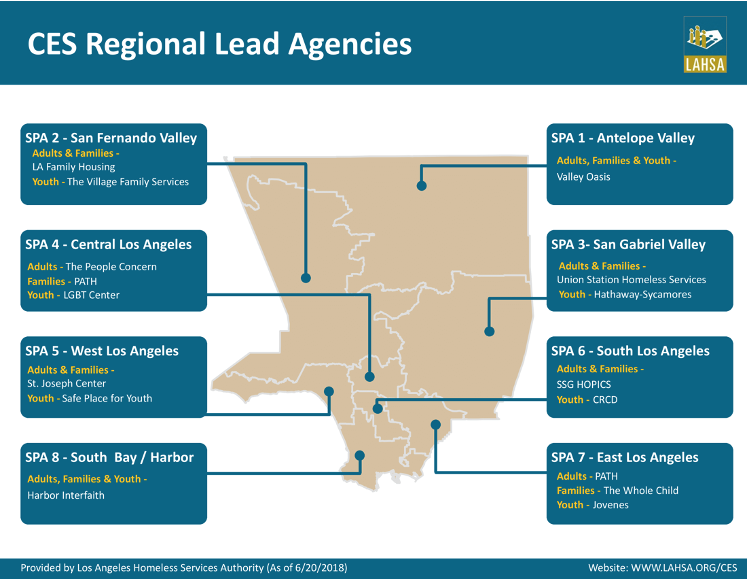
This is the LAHSA SPA area map; you can see for example, that the San Fernando Valley is in SPA 2.
Because I live in the San Fernando Valley, my focus will be on the problems that I have seen for my area of the San Fernando Valley. I do not have access to the maps for other communities other than my community of West Hills. West Hills will therefore be used as an example throughout this article.
I filed a California Public Records Act (CPRA) which I sent to the Executive Director of LAHSA, Heidi Marston, on January 11th, 2022. This is my CPRA to Ms. Marston: CHRISTINE ROWE LAHSA CPRA 01 11 2022.pdf
My concerns during this COVID – 19 pandemic and with the Omicron surge (this was prior to the postponement of the January 25th, 2022 count, was the need for Deployment Centers.
LAHSA ANNOUNCES 2022 POINT-IN-TIME HOMELESS COUNT POSTPONEMENT:
“LAHSA has partnered with Akido Labs to develop a mobile app that uploads data collected to a central server instead of returning paper sheets to local sites for manual tallying. Using the new app will improve data gathering and quality assurance processes while limiting the number of in-person contact volunteers have with Homeless Count staff. LAHSA will continue to improve upon and implement policies and practices that limit the amount of in-person contact during the Homeless Count.
“The Homeless Count is an essential tool in giving us a point-in-time snapshot of homelessness. Data from the Count is used to inform the delivery of services and programs for people experiencing homelessness in Los Angeles,” continued Marston. “This decision is our best path to ensure the accuracy of the Homeless Count without putting the health and safety of persons experiencing homelessness, volunteers, and the community at risk.”
Why can’t this Homeless Count be conducted with no contact between volunteers and other volunteers or even contact with LAHSA staff?
I have attended meetings with two Neighborhood Councils where the SPA 2 Homeless Count Coordinator has been on the ZOOM call explaining the process. For example, in West Hills, the volunteers are expected to meet for the count at the West Hills Shepherd of the Valley Lutheran Church, Founders Hall.
- In the email above to volunteers above, LAHSA’s email states: “Encouraging all volunteers to sign up as a “safety bubble” of two to three people and arrive at the deployment sites together to minimize cross-group interactions”
- The email above also states: “Moving training sessions online to minimize the time volunteers spend at the deployment sites; COVID safety instructions are included in the training”
- In the LAHSA press release above, it states: “LAHSA has partnered with Akido Labs to develop a mobile app that uploads data collected to a central server instead of returning paper sheets to local sites for manual tallying.”
If the Homeless Count data will be captured by an app on a smartphone, why do the volunteers have to g to a Deployment Center such as the church being used in West Hills?
I asked this question of a West Hills Neighborhood Council Board member who has done these counts historically, and who is trying to work with the Deployment Center and LAHSA to count West Hills.
That member of the West Hills Neighborhood Council said that he would be assigning the maps for a specific area in West Hills. He said that there was other paperwork like signed release forms, forms for any discrepancies in the count, and that they needed a team roster. I do not know why this meeting cannot be done online prior to the 8:00 pm time that the count starts.
The Response to my California Public Records Act from LAHSA:
In my CPRA to LAHSA, I had asked why volunteers who are just driving around in their cars during this “point-in-time snapshot count” as referenced above in the LAHSA press release, I had asked why volunteers needed to wear vests. This was the response from Eileen Bryson, Manager of Executive Support at LAHSA:
“Vests are used to help identify volunteers. Vests and flashlights are dedicated to the annual homeless count and are stored in plastic bins in a climate-controlled warehouse between annual counts. Approximately 5,000 vests and 2,000 flashlights are used and are not used on subsequent count nights. Flashlights assist volunteers in traveling down walkways and reading maps. Flashlights and batteries are tested prior to distribution to the deployment sites. Volunteers are welcome to use their own flashlights. Supplies are returned to the LAHSA office by the site coordinators or are picked up by designated LAHSA staff or volunteers.”
I had asked several questions regarding the vests and the flashlights. The above answer is a combined answer to a number of my questions – but some questions were not answered. These are two of them – see my CPRA linked above.
- “Who cleans these vests? What is used to clean these vests? When were they last cleaned? Are they stored in a clean environment that is safe from vermin or other public health potential contaminants of concern?”
- “Why do the volunteers need to use LAHSA’s flashlights? One volunteer said that you need to shine them into cars as you pass by each car to determine if anyone is sleeping inside the car. Is this true – are you supposed to shine a flashlight into a car?”
Now I learn from this CPRA response that some volunteers will be expected to walk in some areas. Will I be expected to walk in my area? That was never discussed in the Homelessness Committee meeting that I attended at the West Hills Neighborhood Council. It was my understanding that this was a driving event only.
As I stated in my CPRA, I thought that if someone had a car, and they had a good enough smart phone to use to use the LAHSA Homeless count 2022 app, that they could afford a flashlight to look at the mapped area and to use their phone. Many newer cell phones even have a flashlight function as it was pointed out the in the West Hills Homelessness Committee meeting.
Does anyone remember the typhus outbreak that we had in Los Angeles a few years back?
I remember an article about Council President Wesson tearing out the carpet in his office due to his concern about fleas:
“Typhus Threat Ongoing, LA County Health Officials Warn”:
I am not concerned about anything viral like COIVD - 19 or even bacterial living on the vests used in the past (more than two years ago, but I am not a microbiologist or other scientist. I am concerned about other substances that may have gotten on the vests that were not cleaned off – and something may have grown on them historically. Could other substances have stayed active on the vests and the flashlights after two years? Something that would cause contact dermatitis for example?
I am also concerned that these plastic bins that were stored in a climate-controlled warehouse – how well is that warehouse maintained? Could there be rodents there that may have contaminated these boxes which in turn, these boxes will contaminate the cars of whomever picks them up.
“LAC DPH Health Alert: Outbreaks of Flea-Borne Typhus”:
“As of 11/23/2021, 83 cases of flea-borne typhus have been identified in Los Angeles County (LAC) residents. LAC Department of Public Health (DPH) has documented an increase in flea-borne typhus cases across LAC compared to the previous 5-year average during the same time period.
Additionally, outbreaks of flea-borne typhus are being investigated in the Westlake neighborhood of LA City and in the unincorporated community of Willowbrook. Each outbreak has 7 cases with symptom onset ranging from April to October 2021. In Westlake, cases most commonly reported exposures to dogs and rodents. Among the 7 cases in Westlake, 3 were experiencing homelessness. In Willowbrook, cases reported exposure to pet dogs and/or cats, rodents, and opossums. All cases were hospitalized and have recovered.”
Typhus is still here – it is an ongoing issue. Has LAHSA considered this factor when it stores vests and flashlights? What does it cost LAHSA to store these items?
What would it cost if in the future, if vests and flashlights were purchased on an as needed basis, and given to the volunteer to keep and to wash for future homeless counts?
The Biggest Issue: The Accuracy of the 2022 Homeless Count
This is the West Hills 2022 Homeless Count map.
The Homeless Count is based upon Census Tracts as stated in the response by LAHSA to my CPRA. But the map that they have assigned to West Hills contains areas that are not numbers based upon the census – I do not know who created the numbers that identify these areas.
For example, the community of West Hills’ southern boundary is Victory Blvd, but the census tracts go beyond those boundaries per the Neighborhood Council boundary which is based on the West Hills community boundary.
Yet LAHSA has West Hills counting parts of Woodland Hills as a part of the West Hills map. Yes, the identifiers of the locations could be attributed to Woodland Hills based upon the app’s coordinates. But why are they calling this the West Hills map, when some West Hills census tracts are missing (or divided) including the area between Fallbrook Avenue and Topanga Canyon Blvd, north of Roscoe Blvd., where I know that a number of current and former West Hills Neighborhood Council Board members live.
Also included in the West Hills map are census tracts that are Unincorporated areas of Westhills, Chatsworth, and Lake View Manor to the LA County line. Why aren’t those unincorporated areas being assigned to an unincorporated LA County area to count when West Hills is in LA City?
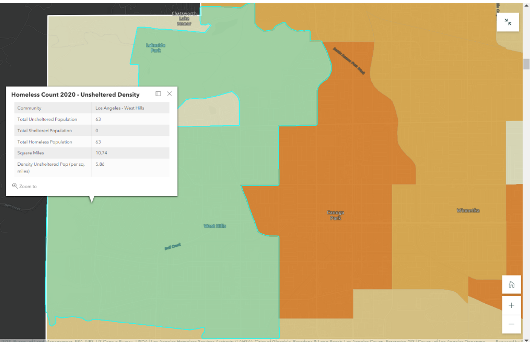
This is a screenshot of West Hills shown in light green from the 2020 Homeless Count interactive map:
This map shows West Hills as if it goes all the way to the LA County boundary in a straight line on the west, and a straight line on the south which is inconsistent with the West Hills true boundaries. It states that there was a total of 63 Unsheltered population within this area, but since it is not shown by census tract, how many homeless people were within the community of West Hills?
Neighborhood Councils:
The Los Angeles City Neighborhood Council system was created in 1999. The Neighborhood Council boundaries are recognized throughout the City of Los Angeles, and they were also recognized in the Redistricting of the Los Angeles City Council, the Los Angeles County Redistricting Commission, and in the Redistricting done by the State of California Citizens Redistricting Commission. That Neighborhood Councils were recognized entities could be seen throughout the Redistricting process based upon Draft and Final Redistricting maps and “Communities of Interest” testimony.
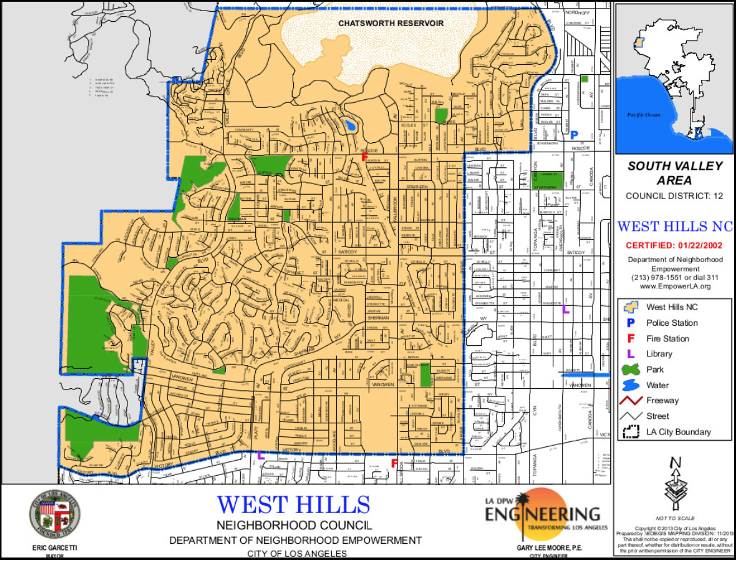
This is the City of Los Angeles West Hills Neighborhood Council map which shows its legal boundaries.
Why isn’t LAHSA using the Neighborhood Council boundaries for their assigned communities on their interactive map and on the map that shows the areas broken down by census tracts that are subdivided?
On the LAHSA website for their 2020 Homeless Count, there are various links to the 2020 Homeless Count data :
For example, there is a link to the City Council District 12 – West Hills is a part of Council District 12 (CD12).
This link states that there were 659 unsheltered in CD 12. Is LAHSA using the actual Neighborhood Council boundaries for that information, or are they doing it by census tract?
Another data link that they give for 2020 is: Vehicles, Tents, and Makeshift Shelters Counted by Geographic Area:
In this document, they identify that number by SPA area Supervisorial District, and by Council District.
In Conclusion:
At the time of this writing, January 30, 2022, while the number of cases of COVID – 19 seems to be declining in Los Angeles County, there is still a risk of catching COVID – 19, particularly the Omicron variant.
This is the press release from the Los Angeles County Department of Health on January 29th, 2022 on COVID - 19: It specifically references increased cases:
- “Outbreaks:
- Residential Congregate Sessions
- Non-Residential Settings
- Homeless Service Settings”
- Why can’t LAHSA take out the deployment centers and do everything virtually including the training, as well as the exchange of consent forms or the distribution of documents to volunteers?
- Why can’t LAHSA create maps based on the Neighborhood Council boundaries which will in turn be reflected more accurately in the Los Angeles City Council and Los Angeles Supervisorial District areas?
- What authority for example, does a Councilmember have to count an area that is not in her or his City Council District? The maps should be based on the new City Council District lines that went into effect after Redistricting for LA City and for LA County purposes for accuracy.
- Why can’t LAHSA create a very highly visible full color poster that can be printed on a home printer that says: 2022 GREATER LOS ANGELES HOMELESS COUNT with the City Seal and the County Seal to be displayed on the car dashboard and attached to the right side of the car with magnets?
- Why should every deployment center be sent vests and flashlights? Can’t this be done based on specific areas that need to be walked? How many areas of the County is LAHSA asking the volunteers to count by walking?
- For example, West Hills is recommended to have 60 + volunteers. When I signed up for the West Hills count, and the last that I had heard, there were only twelve volunteers. Should LAHSA distribute sixty vests, sixty flashlights, and what are called “Packets” – the preprinted forms that were already created when the Homeless Count was planned for January 25th – January 27th, 2022. How much money and time is being spent printing flyers that may go unused?
As a final word of caution, if you are planning to volunteer for the 2022 Homeless Count, I highly recommend that:
- You get a rapid COVID – 19 antibody test the day before or the day of the count to prove that you are not carrying what is called the Omicron Stealth Variant
- Work as family of 2-3, a household (roommates) of 2-3, or pairs of 2-3 people who work together on a regular basis.
- Get rapid test kits from the U.S. Government stockpile for free via mail: gov - Free at-home COVID-19 tests
- If you have access to vests because you have a job or if you volunteer with the City of Los Angeles or the County of Los Angeles, wear your own reflective vest if you think you will need one. I do not know why anyone needs a reflective vest unless they are walking a neighborhood.
- Proof of identification that you are a volunteer for the count – should you be stopped by the LAPD or the LA County Sheriff’s office - should be the letter that was emailed to you when you volunteered.
I always appreciate constructive comments. Thank you for reading and Be Safe!
(Chris Rowe is a 43-year resident of West Hills, California. She is a Public Health and Environmental Health Advocate. She was employed at Northridge Hospital, Tarzana Medical Center, and West Hills Hospital while in pursuit of her college degrees. She has a B.S. in Health Education from CSUN. Chris is a former member of the West Hills Neighborhood Council and she has served on committees of the Woodland Hills Warner Center Neighborhood Council. She has a blog on the USC / Annenburg School of Health Journalism site: Christine Rowe - Member | Center for Health Journalism Chris has written for the Daily News, OURLA.ORG, RonKayeLA.org, and for CityWatch.) She is also the editor of a series of children’s textbooks on animal life written by her husband Bruce M. Rowe, Emeritus Professor of Anthropology at Los Angeles Pierce College.

